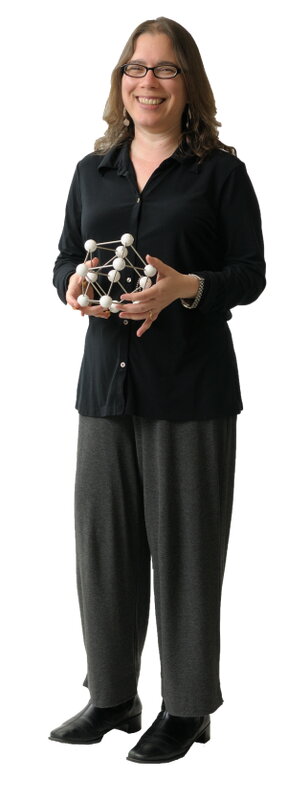
Contact Information
University of Illinois
A512 CLSL, Box 59-6
600 South Mathews Avenue
Urbana, IL 61801
Biography
Professor Murphy received two B.S. degrees, one in chemistry and one in biochemistry, from the University of Illinois in 1986. She received her Ph.D. from the University of Wisconsin in 1990. From 1990-1993, she was first an NSF and then an NIH postdoctoral fellow at the California Institute of Technology. From 1993-2009 Professor Murphy was a faculty member in the Department of Chemistry and Biochemistry at the University of South Carolina. In August 2009 she joined the faculty of the Department of Chemistry at the University of Illinois.
Research Interests
synthesis, properties, chemical sensing, biological applications and environmental implications of colloidal inorganic nanomaterials
Research Description
Our research is at the interface of materials chemistry, inorganic chemistry, biophysical chemistry and nanotechnology. Our primary goal is to develop inorganic nanomaterials for biological and energy-related applications, and understand the chemical interactions of these nanomaterials with their surroundings. A diverse range of projects are currently pursued in the group:
Inorganic Nanoparticle Fabrication and Functionalization.
"Finely-divided metals" such as gold, silver and copper have been known since Roman times for their brilliant colors. These brilliant colors arise fundamentally from the interaction of light with the conduction band electrons in these nanoscale metal particles, producing what is known as a plasmon resonance at particular optical frequencies. Nanorods, compared to nanospheres, have multiple plasmon bands whose position and intensity are intimately connected to the size, shape, degree of aggregation, and local dielectric environment of the nanorods. The absorption and scattering of light by gold and silver nanorods can be tuned throughout the visible and near-infrared portions of the electromagnetic spectrum. We have developed a set of synthetic approaches to fabricate gold and silver nanorods of controlled size and shape in high yields. Molecules can be placed on the nanorod surface using covalent attachment chemistries or polyelectrolyte layer-by-layer adsorption to position them at desired distances, and possibly orientations, from the nanoscale metal surface. On-particle reactions are being explored to improve the compatibility and ease of processing of these materials.
Cellular Imaging, Chemical Sensing, and Photothermal Therapy Using Gold Nanorods.
The strong plasmon bands of noble metal nanoparticles make them ideal for biological sensing and imaging applications. We have used the elastic light scattering properties of gold nanorods as "nano strain gauges" to measure the deformation of soft matrices by living cells. The inelastic light scattering (Raman) properties of gold nanorods can be used to interrogate the local chemical environment of the nanorods. Irradiation into nanorod plasmon bands causes large temperature jumps in the local environment, which we have exploited as a way to kill multidrug-resistant bacteria (once the nanorods are surface-modified to recognize the bacteria).
Environmental Implications of Nanoparticles.
How are nanoparticles distributed and modified in complex biological systems? Can nanoparticles sequester or deliver small molecules across interfaces? How do these processes depend, if at all, on nanoparticle size, shape, aggregation state, and surface chemistry? These are questions that we seek to address using a battery of analytical, physical, and biochemical techniques.
Awards and Honors
2025 NANOSMAT Prize
2022 Centenary Prize, Royal Society of Chemistry
2020 ACS Award in Inorganic Chemistry
2019 Remsen Award
2019 Linus Pauling Medal
2019 MRS Medal
2019 Elected Member, American Academy of Arts and Sciences
2017 Fellow of the Materials Research Society
2015 Elected Member, U.S. National Academy of Sciences
2015 TREE Award, Research Corporation for Science Advancement
2014 Fellow of the Royal Society of Chemistry
2013 Carol Tyler Award, International Precious Metals Institute
2011 Fellow of the American Chemical Society
2011 Inorganic Nanoscience Award, Division of Inorganic Chemistry, American Chemical Society
Additional Campus Affiliations
Head, Chemistry
Larry R. Faulkner Endowed Chair, Chemistry
Professor, Chemistry
Professor, Beckman Institute for Advanced Science and Technology
CAS Professor, Center for Advanced Study
Professor, Bioengineering
Professor, Materials Research Lab
Professor, Micro and Nanotechnology Lab
Professor, Biomedical and Translational Sciences
External Links
Honors & Awards
2022 Centenary Prize, Royal Society of Chemistry
2020 ACS Award in Inorganic Chemistry
2019 Remsen Award
2019 Linus Pauling Medal
2019 MRS Medal
2019 Elected Member, American Academy of Arts and Sciences
2017 Fellow of the Materials Research Society
2015 Elected Member, U.S. National Academy of Sciences
2015 TREE Award, Research Corporation for Science Advancement
2014 Fellow of the Royal Society of Chemistry
2013 Carol Tyler Award, International Precious Metals Institute
2011 Fellow of the American Chemical Society
2011 Inorganic Nanoscience Award, Division of Inorganic Chemistry, American Chemical Society
Recent Publications
Shiratori, K., West, C. A., Jia, Z., Lee, S. A., Cook, E. A., Murphy, C. J., Landes, C. F., & Link, S. (2025). Machine Learning to Adaptively Predict Gold Nanorod Sizes on Different Substrates. Journal of Physical Chemistry C, 129(12), 5913-5920. https://doi.org/10.1021/acs.jpcc.5c00244
Tetrick, M. G., Emon, M. A. B., Doha, U., Marcellus, M., Symanski, J., Ramanathan, V., Saif, M. T. A., & Murphy, C. J. (2025). Decoupling chemical and mechanical signaling in colorectal cancer cell migration. Scientific reports, 15(1), Article 4952. Advance online publication. https://doi.org/10.1038/s41598-025-89152-4
Unnikrishnan, M., Gruebele, M., & Murphy, C. J. (2025). Protein Denaturation at the Air-Water Interface in the Context of Nanoparticle Soft Corona Studies. Langmuir, 41(22), 13902-13915. https://doi.org/10.1021/acs.langmuir.5c00761
Tetrick, M. G., & Murphy, C. J. (2024). Leveraging Tunable Nanoparticle Surface Functionalization to Alter Cellular Migration. ACS Nanoscience Au, 4(3), 205-215. https://doi.org/10.1021/acsnanoscienceau.3c00055
Unnikrishnan, M., Wang, Y., Gruebele, M., & Murphy, C. J. (2024). Nanoparticle-assisted tubulin assembly is environment dependent. Proceedings of the National Academy of Sciences of the United States of America, 121(28), Article e2403034121. https://doi.org/10.1073/pnas.2403034121